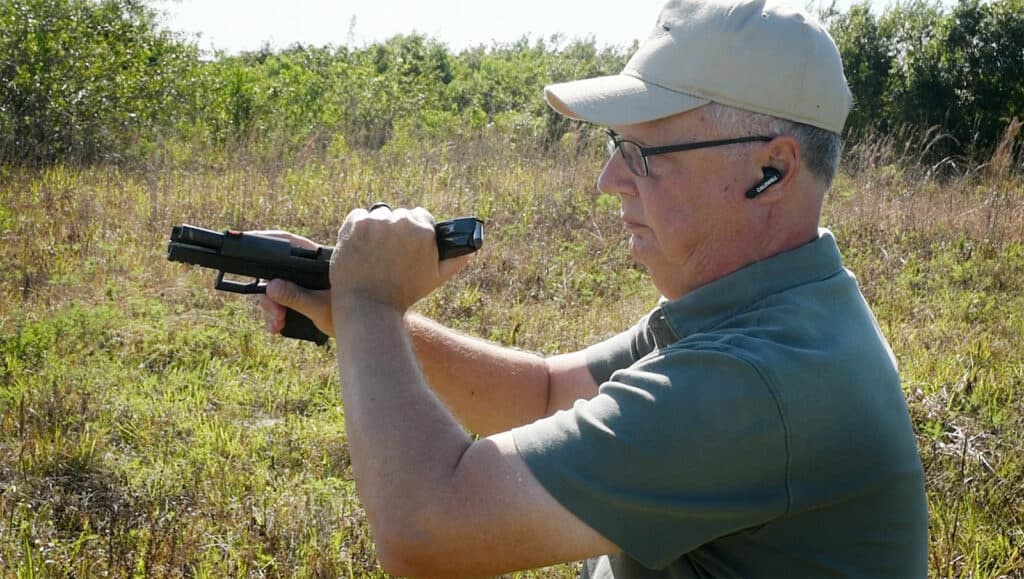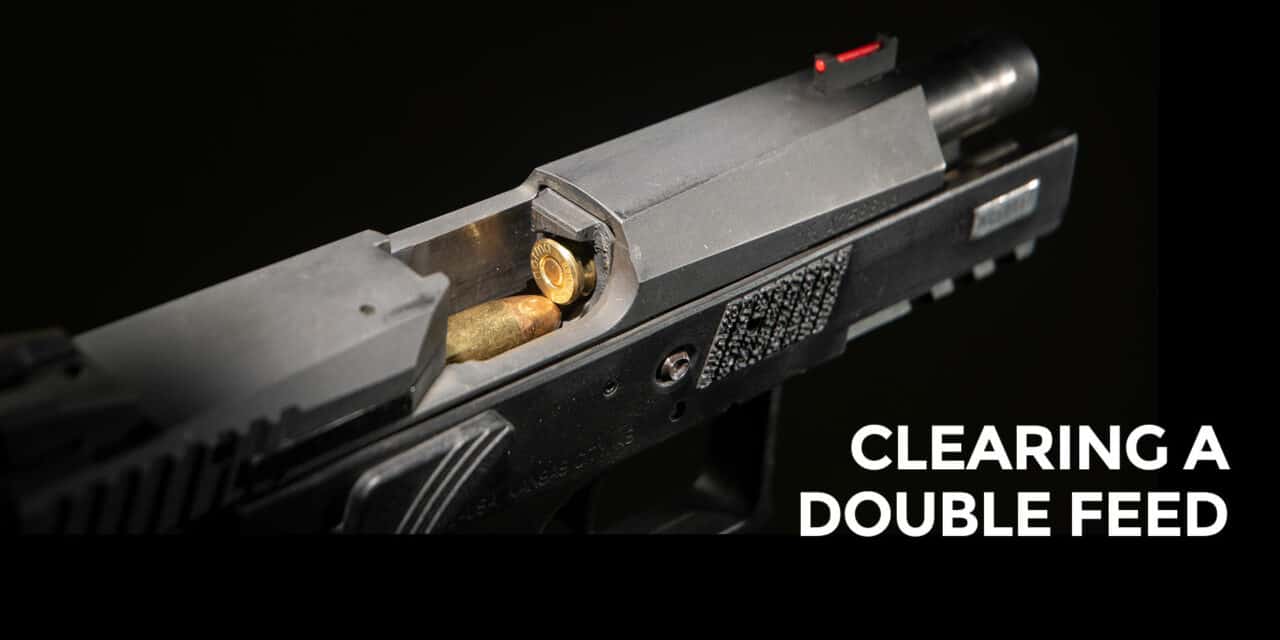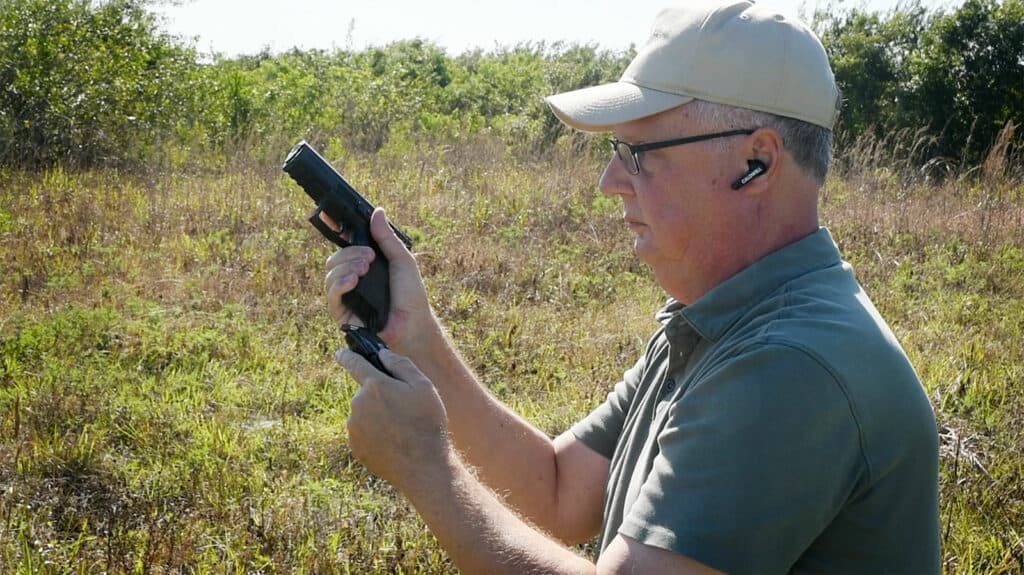The Double Feed / Type 3 Malfunction
You rely on your defensive firearm to be ready for use if you need it to defend innocent life. However, we live in a world ruled by Murphy’s Law. “If anything can go wrong, it will.” This means that knowing how to keep your gun in fight when things go wrong is an essential part of being a confident armed citizen. Having a double feed, or Type 3 malfunction is definitely one of the things that might go wrong when firing a pistol. They look bad, and they take some training and practice to solve efficiently, but knowing how to clear one helps you get your gun back into the action as quickly as possible.
Third Time Is NOT The Charm
We’ve talked about using a “Tap Rack Bang” to deal with a failure to extract, or Type 1 malfunction. We’ve also discussed a failure to eject/stovepipe malfunction, aka a Type 2 malfunction. Clearing a Type 2 malfunction takes a little more effort than clearing a stovepipe, so it only makes sense that clearing a Type 3 malfunction takes even more effort to clear.
A Type 3 malfunction / double feed is just that: Two rounds of ammunition are jammed into the chamber at the same time. This can be caused by one of two things:
- The magazines or ammunition for your gun don’t work reliably, and feed more than one round at a time into the chamber of your gun. For instance, some guns (old 1911s, for example) are notorious for having issues with hollow point ammunition. There is no real way to say “This ammunition is not going to work with this gun.” In reality, it’s often trial and (a lot) of error.
- There was an error in either attempting to clear a different type of malfunction, resulting in a Type 3 malfunction.
That second point probably needs a bit more explanation. Let’s say that you’ve unfortunately had a Type 1 malfunction and had to perform a tap rack bang drill. However, you didn’t perform that second part, racking the slide to load a new round, correctly. Now you have a pistol with a round in the chamber and another round that is trying to load into the chamber, but can’t get there. This is the essence of a double feed, and it takes a bit of effort to clear.
How Do You Know If You Have A Type 3 Malfunction?
Diagnosing a double feed begins the same as other pistol malfunctions. Your sights are on target, you’ve made the decision to shoot, you press the trigger, and nothing happens. Your first step should be to immediately look into the ejection port of your pistol and see what’s going on. If the slide is locked back and there’s no casing caught in the election port, you have a tap rack bang drill to perform in your (very) near future. If there is a casing caught in the gun, you have a stovepipe malfunction, and proceed accordingly.
However, if you look at your gun and you see a shell casing in the chamber and another round trying to force its way into the same space, you have a Type 3 / double feed malfunction, and need to perform the following drill.
- Lock the slide back. It may look like it’s locked back. However, in reality, it’s trying to force a round from your magazine into your gun. This brings everything to a halt.
- Press the magazine release, and physically strip the magazine from your gun. Chances are, that round that’s trying to force its way into your gun is going to prevent the magazine from falling freely out of the gun, which means you’ll have to grab it and pull it out yourself.

Step 3a: If you don’t have a spare magazine, hang onto your magazine as you vigorously rack the slide three times to clear the chamber, then reload
Okay, Now What?
This next step is a decision point for you. If you have a spare magazine, drop the magazine that’s in your hand and proceed to the next step. If you don’t have an extra magazine, you’ll have to retain this magazine as you clear your gun. I use the little finger to my support hand to do this, but I’ve seen other people hold it in their gun hand, stash it in a pocket or even hold it in their teeth as they clear their gun.
- Now that you’ve cleared one of the two rounds, it’s time to clear out the round in the chamber. Grasp and rack the slide at least twice to make sure the gun ejects the round round that’s in the chamber.
- Insert either your spare magazine or the magazine you kept with you, rack the slide and get your gun back into the action.
A Solvable Problem
As you can imagine, clearing a Type 3 malfunction can take a fair amount of time to perform. Every second you use to clear a double feed is a second you’re not sending rounds downrange. Even worse, it could happen when lives are on the line, with threatening rounds headed your way as you try to fix your gun. In that case, clearing a double feed by first finding cover or some other place of safety, then clear your gun.
Knowing how to keep your gun up and running gives you confidence that you’ll be able to handle one of the weird things that might happen when seconds count and coolness under pressure can literally make the difference between life and death. Clearing a malfunction is part of this, as are the basics of marksmanship and a combat mindset. Keep your gun running, your mind sharp and your sights on target, and stay out of trouble. The life you save may be your own.





